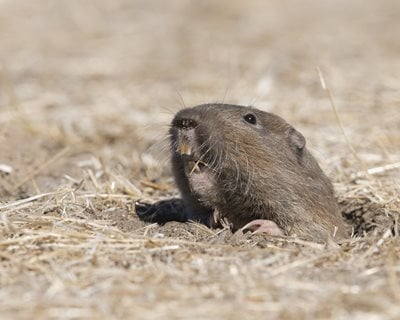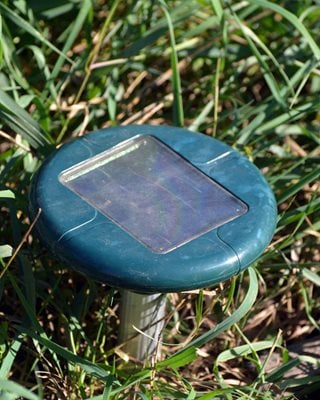How to Keep Gophers Out of Your Yard and Garden
Humane and natural gopher control methods that will keep them from destroying your garden
Photo by: Matt Knoth / Shutterstock.
Gophers, also called pocket gophers, are small rodents that live in tunnels under lawns and gardens. They are a seasonal recurring problem in some areas, but can be a constant problem in others. Gophers seldom venture above ground, so it’s a battle generally fought underground. They target moisture-rich roots of plants and trees and can ruin years of growth in just a matter of hours. Additionally, the holes and dirt mounds that they create can be serious tripping hazards for people and pets, and their tunnels can weaken the ground to the point of causing patios and walkways to collapse.
The size of your yard or garden, the type of plants you have, and the areas surrounding your yard can all affect the rate of success you’ll have with gopher control. The quicker the problem is identified and action is taken, the better. If you’re looking for ways to keep them from destroying your yard or garden, short of blowing them up Caddyshack-style, here are some humane ways to try:
Barriers
Gopher mesh barrier: Create a perimeter or in-ground fence around your garden or lawn with galvanized gopher mesh or chicken wire. The barrier should extend into the ground 1 to 2 feet and above ground as well. They may dig right up to the barrier and you can wage your war there.
Under-lawn barrier: Lay galvanized gopher mesh 4 to 6 inches under the soil when planting a new lawn, laying sod, or in shallow flower beds. It’s a tremendous amount of work for large areas, but if you have a serious problem it can save your lawn for many years to come.
Gopher baskets: If installing an entire foundation or perimeter of mesh isn’t practical, wire mesh baskets can be placed around individual plants that you want to protect. These can be a good solution to protect prized rose bushes, fruit trees, succulents or vegetable gardens. Gopher baskets are available in multiple sizes and are usually made of chicken wire or galvanized mesh, which will last longer.
Plants
Plants gophers won’t eat: Gophers usually won’t eat daffodils (Narcissus) and most allium, onion or garlic plants, so you’re safe planting as many of those as you want.
Plants that repel gophers: Other plants can be used to repel gophers, such as gopher spurge (Euphorbia lathyris), crown imperials, lavender, rosemary, salvia, catmint, oleander and marigolds. Try planting a border around your flower beds or vegetable garden with these. Some of these will also repel unwanted insects like mosquitoes.
Repellent Products
Scent: Repellents that rely on scent can be somewhat hit or miss, because it can be difficult to get enough of it deep enough into their underground spaces. Also, when applying any repellent product to the holes, you need to get it in every hole that you see. Some that you can try are:
- Pine disinfectants: Soak a rag and stuff down the hole.
- Chili powder: Sprinkle inside hole as far down as you can get it.
- Peppermint oil: Soak cotton balls and place in hole.
- Fabric softener sheets: Place in the hole.
- Garlic stakes: These small stakes contain garlic oil and can be placed throughout your yard in the gopher’s holes.

Photo by: Sergey Kamshylin / Shutterstock.
Castor oil granules: Spread the granules over the yard where gophers are the worst, and water them in. The granules will dissolve and release a scent underground that is unpleasant to gophers and moles. Apply castor oil granules in stages, starting at the furthest part of the yard and expanding the treated area closer to the exit with applications every couple of days. The gophers aren’t harmed, just ushered out of your yard and sent elsewhere. Follow instructions for application rate.
Sound: Gophers are sensitive to loud noises and may be annoyed enough by a loud radio, or even windchimes, to move along. This is generally a short-term solution and won’t completely solve the issue.
Ultrasonic repellents: Most of these products are battery or solar powered. The ultrasonic vibrations they put out aren’t harmful to humans or pets, but are annoying to gophers. Ultrasonic repellents are visible above ground, but can be placed in out of the way locations around the yard.
Predatory Animals
Although these options may not be non-lethal ways to get rid of gophers, they’re certainly natural ones.
Barn owls: A gopher’s #1 enemy are barn owls, and a small family of them can eat up to 1000 gophers a year. Encourage barn owls to take up residence in or near your yard by installing owl nesting boxes. Keep in mind though that there needs to be a pretty steady supply of gophers to keep the owls around.
Gopher snakes: True to their namesake, gopher snakes will eat gophers; however, they only eat every four to six weeks, so they’re not very efficient if you have multiple gophers.
Pets: The presence of dogs and cats can make life uncomfortable for gophers and they might move on. Some cats and dogs will chase and kill gophers; however, gophers can carry diseases, so this isn’t always a good idea. Ultimately, the biggest threat to pets from gophers is if they get ahold of one that has ingested poison, thus transferring the poison to your dog or cat - one huge argument for not using any type of gopher poison or gopher bait.
Live Traps
Live traps will catch some gophers and give you the opportunity to relocate them. However, gophers are fairly prolific breeders and in mild climates they can have three to five litters per year, so trapping is needed year-round. Your best solution for live trapping may be to hire a professional who knows how to place traps successfully and how to handle the gophers once trapped. Traps are more practical for smaller areas.
How to set a gopher trap: If you’d like to try your hand at trapping, you’ll be most successful placing the traps in the main tunnel runway which is usually five to ten inches below ground. Follow the exit hole down to the main tunnel, which usually leads away in the direction of the flat side of the above-ground dirt mound. You can also use a long metal rod or screwdriver to poke down through the dirt to help you locate the tunnel. Dig down to the tunnel and place two traps back to back, with one facing each way down the tunnel, or use a 2-door trap. One popular bait to use is Juicy Fruit gum. Some swear by it and say that when the gophers eat it, it will clog their intestines and kill them. It may work, but you’ll probably find it’s best simply used as bait. Check the traps intermittently and handle them carefully once the gophers are trapped.
Call a professional: If you’re in need of a quick solution, have a large area to treat, or are heavily infested, you may want to call in a professional for gopher removal. Once they’ve come in and gained the upper hand, you may be able to take over and maintain control.
For particularly stubborn gophers it may take multiple approaches used simultaneously, such as repellent plants, an ultrasonic repellent and some physical barriers. After all, the only permanent solution would be to concrete your entire yard.
Methods Not Recommended
Flushing water down their tunnels to drown or chase them out is not recommended and may even make the situation worse. The excess water softens the ground, actually making it easier for them to dig. Gophers have many tunnels they can escape in and even block off temporarily. Their tunnels may run under patios or walkways and the underground flooding can cause damage or even collapse.
Poison bait is just as deadly to your pets as it is to the gophers who consume it. Rodenticide is the most commonly ingested poison by dogs; they either eat it directly or get secondary poisoning from getting ahold of a poisoned gopher. Either way, there are disastrous results. The same holds true for birds of prey, owls or hawks, that eat gophers or other rodents that have ingested poison. It’s just not worth the risk to use poison.
Igniting propane, butane or natural gas in the tunnels is dangerous, and although it might get the gophers, you’ll most likely do irreparable harm to the plant roots that you’re trying to protect in the first place.
Using gas-producing flares or blowing exhaust into the tunnels isn’t always effective either. Gophers have a keen sense of smell and are able to plug up their tunnels rather quickly. Pumping exhaust from a lawn mower through a garden hose is exceptionally dangerous as the exhaust is extremely hot and can melt the hose.

Photo by: Yhelfman / Shutterstock.
Gophers 101
With any type of pest problem, identifying the culprit is the first step. A common pocket gopher is larger than a hamster and has a tail that is shorter than a rat or mouse. They have small ears that don’t stick out from their head and prominent front teeth. They have whiskers that help them move around and gauge the width of their tunnels. Gophers also have keen senses of smell and hearing, but their sight can be somewhat limited, especially when first exiting the dark tunnels into daylight. Gophers rarely venture out of their tunnels and spend most of their time underground.
A classic gopher mound is C-shaped around the entrance hole and is made as he pushes the dirt from the tunnels to the surface. The entrance and exit holes drop down at an angle to the main runway. Gophers make many side tunnels, hideouts and nests that branch off the main runway, as well as other entrance and exit holes.
Gopher vs Mole? A gopher mound is C-shaped, but a mound made by a mole is more like a volcano and surrounds the entire entrance hole. Moles don’t eat plants or roots, but eat grubs and earthworms. Their burrows are more shallow than gophers, often making surface ridges in the lawn or garden.
RELATED:
How to Get Rid of Squirrels
How to Get Rid of Voles in Your Garden
Rabbits - Natural Ways to Protect Your Garden
